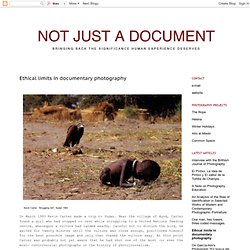

A Pulitzer-Winning Photographer's Suicide. NOT JUST A DOCUMENT: Ethical limits in documentary photography. Finally, the way in which the work is displayed and presented to the public is also crucial in order to judge weather the practitioner’s attitude was or not ethical.

If the aim of photojournalism and documentary photographers is that of “creatively inform” society about current issues and condemn certain attitudes that could conform the absence or violation of Human Rights, it would be their duty then to try and communicate such a reality to the largest group of spectators as possible, trying not to turn the subject matter into something banal due to an inappropriate way of showing the work. In this sense, Carter’s photograph was presented in the front page of one of the most popular US newspapers, The New York Times, and then reproduced in hundreds of them worldwide.
PRESS:THE LIFE AND DEATH OF KEVIN CARTER Visiting Sudan, a little-known photographer took a picture that made the world weep. What happened afterward is a tragedy of an. The image presaged no celebration: a child barely alive, a vulture so eager for carrion. Yet the photograph that epitomized Sudan's famine would win Kevin Carter fame - and hopes for anchoring a career spent hounding the news, free-lancing in war zones, waiting anxiously for assignments amid dire finances, staying in the line of fire for that one great picture. On May 23, 14 months after capturing that memorable scene, Carter walked up to the dais in the classical rotunda of Columbia University's Low Memorial Library and received the Pulitzer Prize for feature photography.
The South African soaked up the attention. "I swear I got the most applause of anybody," Carter wrote back to his parents in Johannesburg.